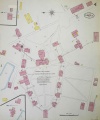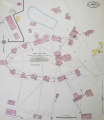Indiana Reform School for Boys
| Indiana Reform School for Boys | |
|---|---|
 | |
| Established | 1867 |
| Opened | 1868 |
| Current Status | Active |
| Building Style | Cottage Plan |
| Location | Plainfield, IN |
| Alternate Names |
|
Contents
History
The 1867 Indiana General Assembly created the House of Refuge for Juvenile Offenders. Governor Conrad Baker selected the site in Plainfield, Indiana. The name changed in 1883 to the Indiana Reform School for Boys, and again in 1903 to the Indiana Boys’ School. Judges from any criminal or circuit court in Indiana could commit juvenile males charged with crimes, incorrigibility, or delinquency. The function of the school was to reform juvenile offenders through education and vocational training.
In the 1890s, the disciplinary system at IBS was semi-military in nature, which can be attributed to the tenure of Colonel Thomas Charleton as superintendent. “The disciplining here is much as it is at West Point or Annapolis, except in this—that, instead of placing under arrest as is done with the worst offenders there, we use some corporal punishment,” Col. Charleton is reported to have said.
Col. Charleton declared himself “a believer in industrial work” and during his tenure began training boys in nineteen different occupations: brick making, brick burning, brick laying, plastering, painting, glazing, gas and steam fitting, gas making, bread making, cooking, tailoring, shoe making, gardening and farming, caring for stock, floriculture, carpentry, laundry, printing, blacksmithing, and making music. In 1900, the badge system was adopted to set release dates for boys. New boys were given a “badge level” depending on the severity of their crime. The boys could earn badges for good behavior and hard work. Under the system, it was possible for a boy to leave the school in one year. In 1901, the institution’s name was changed to Indiana Boys' School, a name it would keep for more than a century. Col. Charleton retired after 20 years as superintendent of the school in that same year and was replaced by E. E. York, who continued the system Charleton had established.
IBS hosted movie crews in 1949 for the shooting of 'Johnny Holiday' starring William Bendix, Hoagy Carmichael and Allen Martin Jr. The movie, directed by Willis Goldbeck, is the story of a young tough street boy who is sent to a boys’ prison. The historic Administration Building, built in 1893, is featured in several scenes.
In 1970, the farm and dairy programs were closed and replaced by a vocational horticulture program. The following year, co-ed activities were added to the school agenda. Monthly activities with the Indiana Girls’ School located about 9 miles (14 km) to the east were incorporated and included a co-ed newspaper called “The Herald and Super-Star Spectrum.” Other co-ed activities were group counseling, school and staff development.
September 1971, the administration of IBS was reorganized to be more efficient. Part of those changes included the initiation of volunteer programs in cooperation with local churches. Some programs included were PACE (Program for All-inclusive Care of the Elderly), Rotarians, Optimists and Jaycees. In June 1973, corporal punishment was halted at IBS following the U.S. District Court trial of a lawsuit filed by two former IBS inmates. One inmate who appeared at the trial said he “was paddled until he bled” and another claims to have been held in solitary confinement for 70 days.
The Indianapolis Re-Entry Educational Facility (IREF) was opened as restricted minimum-security facility for adult male offenders on January 13, 2006. This Indiana Department of Correction (IDOC) facility was converted into the nation’s first correctional facility dedicated to re-entry after serving as the Indiana Boy’s School for over 100 years. IREF relocated to the city of Indianapolis on December 16, 2009 at the site of the former Indiana Women’s Prison.
Charles Manson
Originally sent to the Gibault School for Boys, then to the Boys' Town in Indianapolis. Four days after his arrival there, he escaped with another boy. The pair committed two armed robberies on their way to the home of the other boy's uncle. He ended up at the Indiana Boys School at the age of 13, then escaped in 1951. He was later caught in California after attempting to steal a car.




